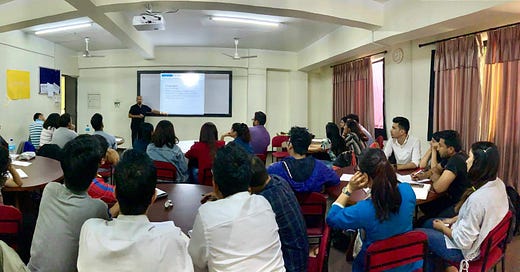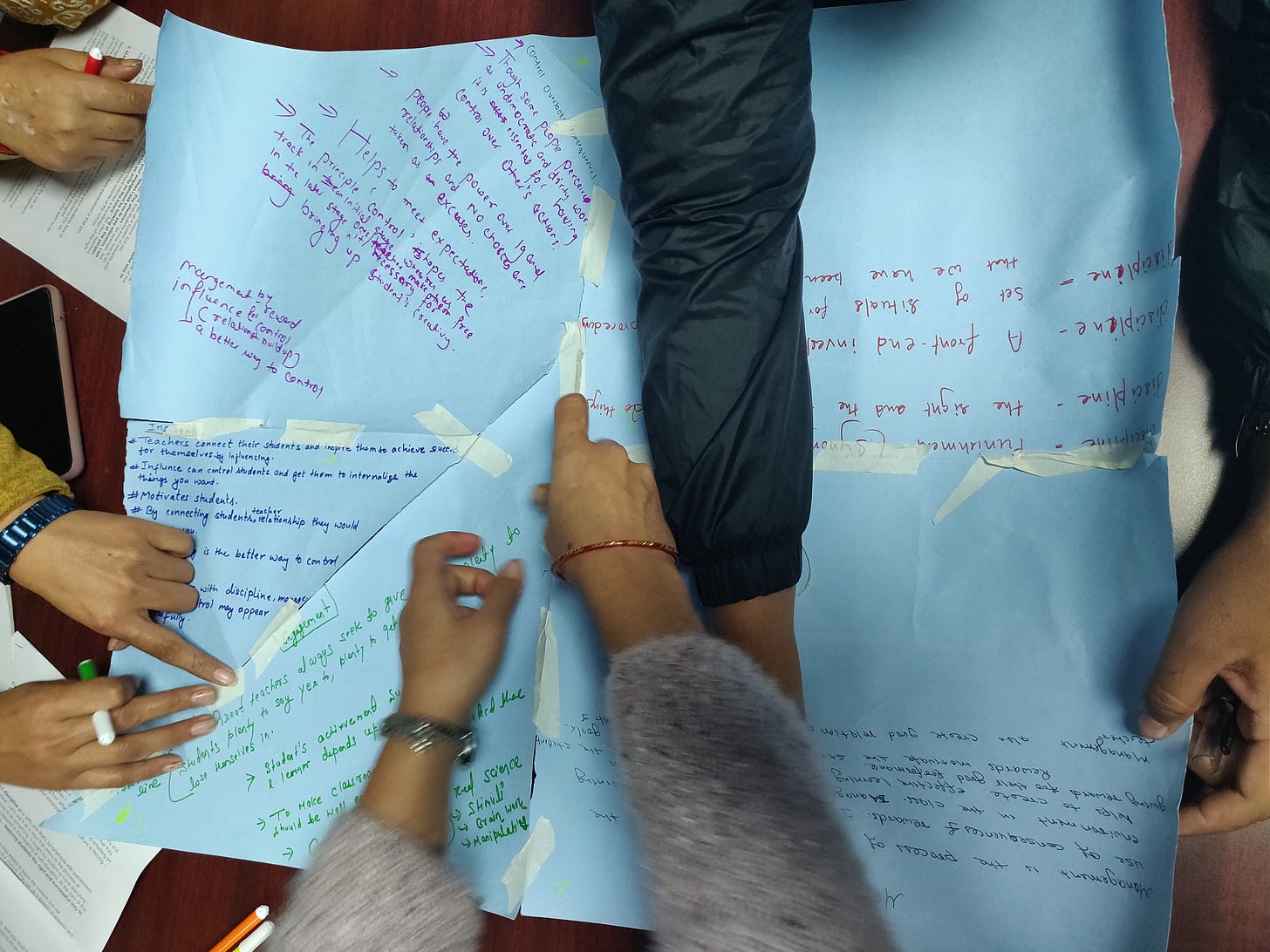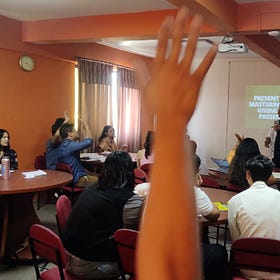Distraction = Enemy of Learning
Of course, many of us might think about distractions as the external noises only.
Like, some students not behaving and creating chaos or wasting everyone’s time. And, random people coming in and out of the class, leaving the door open or shutting it with a thud.
But distractions can also be the result of Mental state. Personal baggage. Cultural context.
And, beyond all the above sources of distractions, one of the major ones is myself as the teacher teaching the class.
Teacher as the Major Source of Distraction
Here are at least nine ways I have created distraction, knowingly and unknowingly, in the classroom - to distract students from doing, thinking, and learning.
Here’s the TLDR version,
By repeating the instructions
By standing up while a student is giving a presentation
By decorating the classroom walls with chart papers
By ignoring the maxim: less is more
By over-explaining concepts and examples
By stacking questions in English and repeating them in Nepali
By taking a detour from the content
By preventing students to pause - think - reflect
By being disorganized, unstructured, and non-linear
Now in depth:
1. By repeating the instructions - twice, thrice, or four times
I’ve learn to shut up after giving an instruction. Sometimes I do display them on the slides for the benefit of those who don’t listen. But that’s rarely. Since I’ve started doing this (telling the instruction just once), students eventually realize that they must be attentive 100% of the time.
2. By standing up while a student is giving a presentation
Visualize this: a student is in front of the class, giving presentation. You as the teacher is standing up, may be on the back or on the sides. Guess where the students is most likely to face towards during the entire presentation? Even when some students will pull it off, most will feel awkward and perhaps threatened.
Now I sit down among students and try to be invisible.
3. By decorating the classroom walls with chart papers
I used to think, “hey the walls are empty, why not decorate it with student works !”
Not a sinister idea at all. However, from the attention/distraction point of view, colorful chart papers usually create visual chaos in the class. May be anchor charts are still helpful for students who are in the novice phase, but as students gain competence and confidence in the content knowledge, just remove them. Keep the walls clean. No more visual clutter.
I still have students work in groups, and stick chart papers or sticky notes as a “secondary hard drive” for a few days, as an external source for information. And then have the students remove them.
(Check out the Split-attention Effect which is caused by poorly constructed instructional materials and busy classroom environments. And this also add to extraneous cognitive load.)
4. By ignoring the maxim: less is more
Classic error. I’ve made this mistake of cramming the slides with content, images, and animations because, for me, everything, every theory, every example looked important. I thought, students deserved more, and thus, let me give more.
Similar on the level of activities, tools and materials in the class.
You could say, more the activities, more the engagement. Isn’t it?
Not really.
5. By over-explaining concepts and examples
Earlier, I was completely unaware about the concept called “working memory”, and how we have such a low capacity to hold new information in our attention for a significant time.
Working memory is a form of conscious memory that allows us to temporarily hold a limited amount of information for immediate mental processing.
John Sweller, who formulated the Cognitive Load Theory, argues that our working memory has a limited capacity; therefore, instructional procedures need to avoid overloading it with those activities that don't directly enhance learning.
Over-explaining is one of the surest way to overload the working memory, resulting in confusion and distraction in the students’ mind.
6. By stacking questions in English and repeating them in Nepali
Again, these might not seem like a problem to other teachers and even to the students. This is such a minor detail.
Does it help some students to be clear about the question? May be.
Or may be this has become your habit to undermine students’ capacity to understand your question in one language?
Now I am aware that I am over-burdening the working memory of the students with “redundant” information. It is also a waste of precious instructional time, thinking time.
Details matter.
7. By taking a detour from the content
Let me make a huge generalization. Most of the teachers have this habit of doing this almost in every class.
I have done it. I’m sure you have done it too.
This is a classic case of: काम कुरो एकातिर कुम्लो बोकी ठिमीतिर !!! A Nepali proverb which literally means, ignore your work and go to Thimi to roam around.
Some might say, a little bit of detour and random/irrelevant stuff once is a while is good for building relationship and creating a positive environment in the class. I agree.
But how much “once in a while” is once in a while.
8. By preventing students to pause - think - reflect
This is probably the biggest reason why “lecture” based teaching gets the demeaning treatment ! And in many ways, teachers are to be blamed.
Most teachers love speaking.
I’ve even attended a workshop on “Activity based teaching” in which the trainer was basically presenting/lecturing the whole time. Slide after slide after slide.
I’ve done something similar. Not allowing time and opportunity for students to take a mental break. To pause, think, and reflect.
Now it’s a regular routine in my classes, to plan for student thinking and reflection.
9. By being disorganized, unstructured, and non-linear
I’ve heard teachers claim with pride, “Some of the best classes I’ve taken are the ones for which I did not prepare at all.”
Awesome. You probably are the perfect combination of expert and experienced teacher. May be it was just a pure chance.
However we can’t leave “learning” in the hands of a pure chance.
Not having an organized class, structured content, and linear process is the easiest way to create “traffic jam” in the class.
p.s.
A thought formed in my mind and it went away before I posted this… but now I realize I was thinking through this line of Leo Tolstoy's novel Anna Karenina, "Happy families are all alike; every unhappy family is unhappy in its own way."
In some ways, effective teachings are all alike; every ineffective teaching is ineffective in its own way. Just a thought.
The source of my realization:
My teaching methodology took a significant u-turn after I stumbled upon this tweet by Dylan Wiliam.
This got me deeper into the premises of Cognitive Load Theory, and then into the learning science and cognitive science.
I’m sure, this will change yours too.
Relevant posts for further reading:
3 Videos about Attention, Learning and Monotasking
This post is a response to some of the queries I got after my earlier post on “10 Truisms in Teaching and Learning”. They specifically wanted some more resources that illustrated the relationship between attention (memory), learning, and multitasking
Being Pro-active about Attention
ATTENTION IS THE MOST VALUABLE CURRENCY FOR LEARNING And, mobile phones are the biggest distractions in the classrooms, and in workshop sessions. If students are expected to give 100% attention in the class, we expect the same from the workshop participants 🙂
Classroom Management is the Last Thing...
A REAL problem all teachers face: One of the most common challenges almost every teacher faces almost every day is classroom management and handling student misbehavior. In the almost 8 years of working with other teachers as a teacher developer, I’ve heard this from teachers again and again.











As a lecturer I am clapping for all of these points. I can utilize these as ways to become a more conscious professor.
I’ve learned that I have a preferred teaching style and am always willing to test theories in regard to my teaching style effectiveness in relationship to students learning retention and independence abilities to recant class material.
To me, if I’m preventing the majority of my students from developing then I have to make changes. So, to wrap this up, I enjoyed the fact that you’re normalize the idea of the instructor being responsible for distractions. The instructor is best when he/she is always a student and places the students success above their ideas of success.
I had never thought from this perspective. I have done most of the things metioned here and I thought it was a normal things to do.